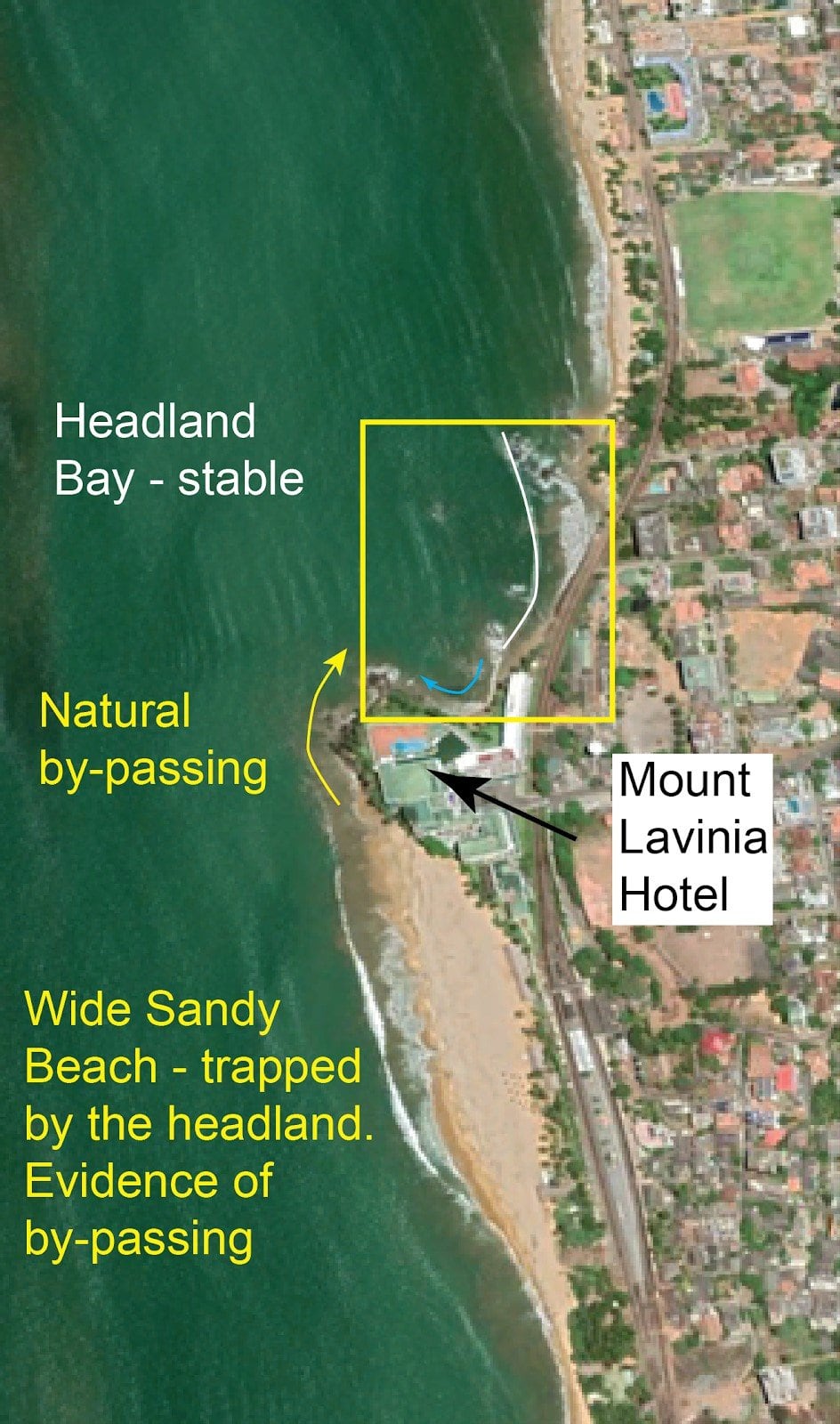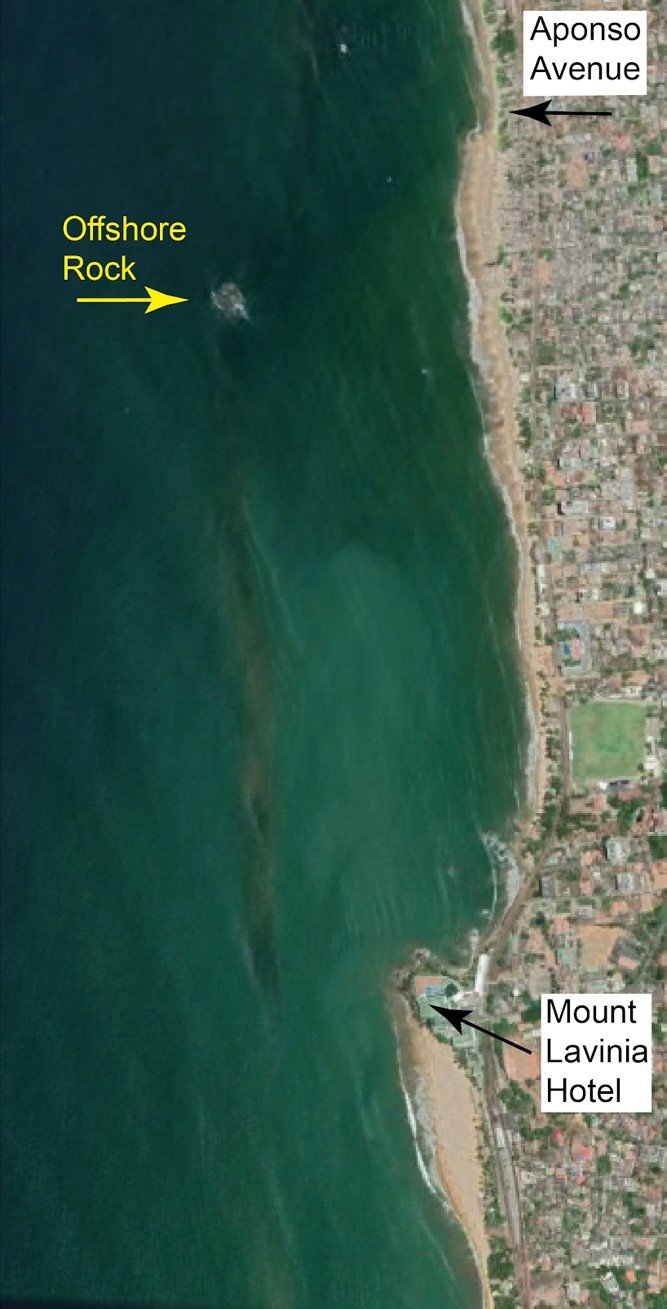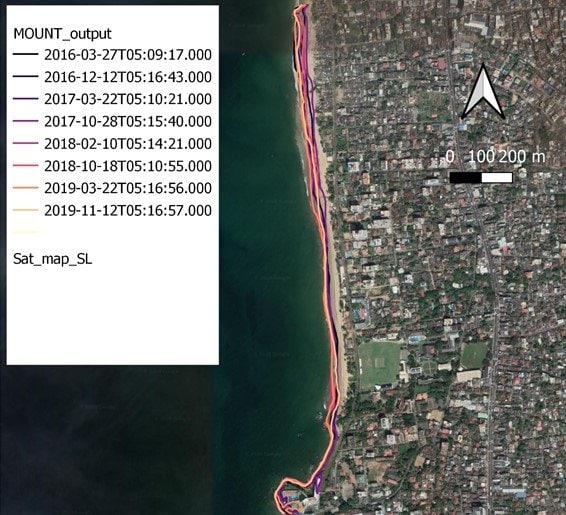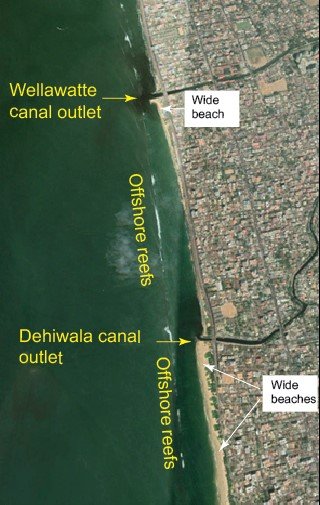Charitha Pattiaratchi1, Nadiya Azmy2 and Asha de Vos1, 2
1The Oceans Institute, University of Western Australia, 35 Stirling Highway, M470, Crawley WA, 6009, Australia
2Oceanswell, 9 Park Gardens, Colombo 5, Sri Lanka
Email: chari.[email protected] and [email protected]
Key Points
- Sand nourishment of Mount Lavinia beach appears to have no tangible outcomes with respect to aims of the project. The exercise appears to have been undertaken without adequate planning, detailed studies and ignoring basic coastal engineering principles.
- The Coast Conservation Department has stated that the aim of the project is to create a 15 m beach at Wellawatte through the sand engine method. Here, 150,000 m3 of sand was placed on Mount Lavinia beach and is expected to be transported to Wellawatte.
- A considerable amount of money has been spent. It is expected, through design or otherwise, that the majority of the sand will be washed away from Mount Lavinia beach after the south-west monsoon season.
- The coastline between Mount Lavinia and Wellawatte has remained relatively stable for many decades albeit with seasonal changes.
- The sand deposited at Mount Lavinia has to pass three major natural and artificial structures: Rock at Aponso Avenue and the training groynes at the two canal outlets at Dehiwala and Wellawatte.
- The percentage of sand deposited at Mount Lavinia making it as far as Wellawatte is likely to be small and certainly not large enough to create a 15 m beach. Also consider that the existing seasonal change in the beach is larger than 15 m per annum.
- The additional sand supply could impact the coastal reef systems and affect the siltation patterns of the Dehiwala and Wellawatte canal outlets.
Report
This short report relates to the recently concluded beach nourishment project carried out during the COVID-19 period at Mt. Lavinia beach. During this period, the Coast Conservation Department (CCD) dredged 150,000 m3 of sand 2-6 km offshore of Ratmalana station (under license from the Geological Survey and Mines Bureau of Sri Lanka1) and placed it on Mount Lavinia beach. As per the CCD Director General Prabath Chandrakeerthi’s statement in an article published in the Daily Mirror of 1st June 2020, the objective of the project was to form a 15 m wide beach at Wellawatte through northward sand transport from Mount Lavinia2.
Here, we undertake an analysis of the current situation. We use personal experience and knowledge of the coastline, given that two of the co-authors (Pattiaratchi and de Vos) have used this coastline extensively over at least 4 decades through participation in sea swim events and scuba diving on the reefs and wrecks in the vicinity, and Google Earth and Sentinel satellite imagery. The Google Earth imagery was obtained on 5 April 2020 – just prior to the commencement of the beach nourishment project, reflecting the existing state of the beach. The area under consideration is a 5 km stretch of beach between the Mount Lavinia headland to the Wellawatte canal outlet.
The stability of a beach depends on sand transport alongshore (parallel to the beach) and cross-shore (perpendicular to the beach). Along the west coast of Sri Lanka the net transport of sand is from south to north in response to the south-west monsoon waves and swell waves originating from the Southern Ocean. It is estimated that ~230,000 m3 of sand is transported from south to north annually. As is the case with beaches globally, there is a seasonal variation in the beach width. In the event of energetic waves with long wave periods, there is onshore transport of sand along the sea bottom resulting in an increase in beach width. In contrast, during energetic breaking waves with small wave periods, such as those experienced during the south-west monsoon season, strong offshore transport occurs, the beach is eroded and beach width decreases. Therefore, along this stretch beaches are narrow during the south-west monsoon and wider during the north-east monsoon. This is not erosion/accretion but the natural variability.
The major geological formation off Mount Lavinia is the prominent headland represented in Figure 1. To the south, the headland traps sand resulting in a wide beach providing a great amenity to hotel residents. The sand extends offshore to the end of the headland indicating that sand can move from south to north around the Headland. Coastal headlands and their associated beaches are considered the most natural beach landforms. This is because waves diffracting (Diffraction refers to various phenomena that occur when a wave encounters an obstacle or a slit. It is defined as the bending of waves around the corners of an obstacle or through an aperture into the region of geometrical shadow of the obstacle/aperture) at the headland approach the beach at right angles minimising the longshore transport (Longshore transport refers to the transport of sand parallel to the shore by the combined action of waves, tides and the shore-parallel currents produced by them). The beach to the north of the hotel is controlled by the headland. This is evident in the image which shows the wave crests approaching parallel to the beach as represented in Figure 1 above. The presence of many rocks and boulders will also act to break the waves. Therefore, this part of the beach is stable.
The 1.6 km stretch of beach between the Rock at Aponso Avenue and Dehiwala canal outlet is protected by a shallow reef parallel to the coast as evidenced by the breaking waves. The presence of the reef dissipates the wave energy and provides protection to the beach. Nevertheless, there is still sand transport and with the training groynes at the entrance acting as a barrier to northward sand transport, there is significant accumulation of sand to the south of the Dehiwala canal outlet as depicted in Figure 5. Again, there is no evidence of erosion along this stretch of the coastline. This is highlighted by examining the shoreline change maps created using the Sentinel satellite over the period of March 2016 to November 2019 (Figure 4). The seasonal changes as mentioned above are reflected but there is no systematic erosion.
On the contrary CCD Senior Engineer (Coastal Design & Research) Sujeewa Ranawaka states that the sand that naturally flows downriver from the country’s interior is used to maintain the [dynamic] equilibrium (the fluctuating geometry of the beach over time) of the beach, but due to excessive sand-mining in the Kalu and Kelani rivers an insufficient supply of sand has resulted in sea erosion on the west coast4.
He further stated, “when the natural supply of sand ceases, the sea erodes the shore to obtain the sand needed to maintain the equilibrium”, and added that seawater and ocean currents in Sri Lanka’s west coast carry some 230,000 cubic meters (350,000 tonnes) of sand northward along the shore every year – highlighting that this sand must come from the country’s rivers4. In response, Prof. Charitha Pattiaratchi, lead author of this report emphasises that the Kelani River does not have an influence on this 5 km stretch of the beach.
The pattern of sand accretion/deposition repeats at the canal outlets at Dehiwala and Wellawatte (Figure 4). Here, coastal structures have been built to prevent sand deposition at the outlet to keep it open. The accumulation of sand to the south of the outlets results in wider beaches while those to the north of these structures are narrow due to the trapping effect of the training groynes.
Summary
Summarising the above description of the beach processes and variability along the 5 km stretch of beach between the Mount Lavinia headland to the Wellawatte canal outlet, it is clear that no erosion is occurring over this stretch of the coastline – it has been stable for many decades. Instead what we see is the natural variability of the beach resulting from seasonal changes in the incident wave climate in the area as a result of our monsoonal climate.
In the engineering approach to designing a sand nourishment project, detailed investigations are undertaken to define the outcome of the nourishment and CCD has indicated that the aim was to create a 15 m wide beach at Wellawatte2, 5 km away from Mount Lavinia where the sand was placed (the length of this beach to define a volume calculation is not available). In this situation it is imperative to define a sand budget for the study area which then allows for calculating the volume of sand that is required for nourishment and where to place that sand. There is no record that any of these studies were undertaken as evidenced by a lack of an EIA for the sand nourishment (EIA was undertaken only to dredge the sand from offshore Ratmalana5). In general, in sand nourishment projects, it is expected that a volume of sand equivalent to 2-3 times the amount that is nourished is ‘lost’ from the system. So placing 150,000 m3 (60% annual transport) was a gross underestimate and therefore it is not surprising that the sand was taken away from the beach. CCD has mentioned that the idea of placing sand at Mount Lavinia is a new technique called the ‘Sand Engine Method’4. This method was established along the Dutch coastline and was designed to supply sand over a period of 20 years with the initial placement of 21 million m3 of sand indicating the long-term nature of such an exercise.
Our analysis identified several natural and man-made barriers for northward sand transport between Mount Lavinia and Wellawatte. These include the rock structure at Aponso Avenue and the canal outlets at Dehiwala and Wellawatte. There is no indication of how much sand will bypass these obstructions and whether the siltation as a result of increased sand supply will impact these outlets. It is possible that additional dredging may be required to keep the canal outlets open.
The sand was placed on the exposed beach and moulded onto the beach shape by earth-moving vehicles. If the aim was for the sand to supply Wellawatte, it makes little sense to place the sand on the beach. Rather sand placed just off the beach, below the water level would have been a much more efficient and less expensive means of achieving said goal.
The sand nourishment of Mount Lavinia beach appears to have no tangible outcomes with respect to the aims of the project. The exercise appears to be undertaken without adequate planning and ignoring even basic coastal engineering principles. However, a considerable amount of money has been spent. It is expected, through design or otherwise, that the majority of the sand will be washed away from Mount Lavinia beach after the south-west monsoon season. Some sand has already been removed by higher energy waves associated with Tropical Cyclone Amphan. The percentage of sand deposited at Mount Lavinia beach making it as far as Wellawatte is likely to be small and certainly not sufficient to create the anticipated 15m beach. The existing seasonal change in the beach is larger than 15m per annum.
Finally, this coastal stretch has significant biological and ecological importances that also impact local livelihoods. Not only is it abundant with sandstone reefs and rocky habitats6, which are used by the diving industry but also by ornamental fish collectors. In addition, the environment offshore from Mt. Lavinia is significant for its various dive sites including shipwrecks which are high in biodiversity but also hold great archaeological value7 and have become increasingly important to our tourism industry. Furthermore, Mount Lavinia beach is considered one of the best beaches in Sri Lanka to observe seashells and molluscs8, some of which are only found in these areas8. The easily accessible rocks at the southern end have been used by students to observe marine flora and fauna9 and the focus of much research.
We believe that as we move forward a thorough review of the decision-making process should be undertaken to prevent another similarly costly exercise recurring in Sri Lanka. Over the next few months, monitoring of critical areas where the additional sand may have an impact should be monitored and should include the coastal reef systems and canal outlets.




